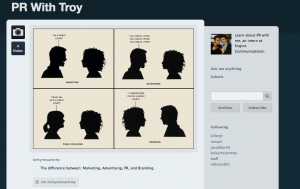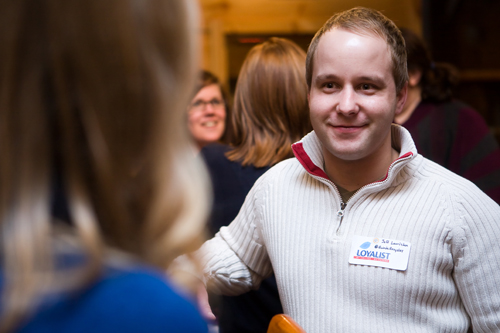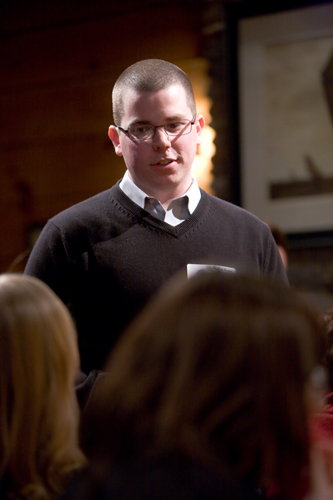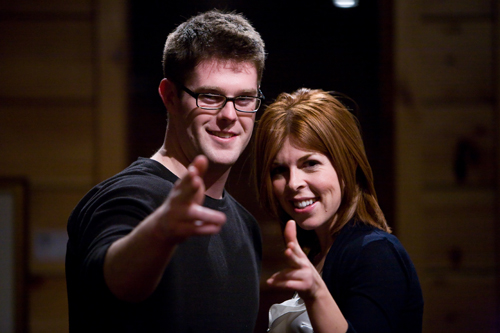Since early this morning I have been considering topics for blogging. I’ve been on this “know thyself” bandwagon, and I didn’t want to inundate you with more, “me, me, me.” But hopefully you’re seeing that it’s not simply about me–it’s about you and your business. (My friend Nate Riggs wrote about this for me on Thursday, and if you haven’t read his guest post, it’s a great resource on this topic.)
As I logged into the blog, I found a really interesting comment waiting for approval. It was in regards to my post from last week entitled, On the Road, where I introduced you all to my little experiment in self-discovery. Here’s an excerpt from that comment that I want to address today:
“[Bryna] I’m continually impressed that you are willing to be the guinea pig, or at least put your feet in the shoes that have to do the walking, as it were (mixing my cliches a bit). And so, in fearing all these traps, I am about to walk into the arena of social networking. I don’t feel I have a choice, at least. And because of it, I will be needing help. So for that reason I ask you for this advice — how do we balance the need to know ourselves with the need to know our audience or at least our customers? I don’t think they are exclusive, but I certainly can’t see them being the same, either.”
First off, let me say thank you. I’m not looking for accolades in terms of sharing myself with you all, but I do appreciate that this commentor understands that I’m not doing it out of a place of self-idolatry (their words–check out the full comment), but to really question the ways we communicate who we are in the social media world.
It’s All About Balance
“How do we balance the need to know ourselves with the need to know our audience, or at least our customers?”
Let’s start with self.
I started this journey of online self-discovery because there are a lot of voices in the social media world, and I wanted to make sure I knew what mine was. It’s not enough to just talk into space, and assume that people will listen. Some will, and depending on why you blog, that’s acceptable. However, for professional bloggers, finding your voice is key to success. My friend, and colleague in the SM space, Matt Cheuvront, actually just posted on this today, and he put it well–it’s ok to experiment with your platform, just be you.
That’s what I’m trying to do, and encourage you to do as well. It’s no longer enough to take the advice of others verbatim. The process of developing your SM platform is just as important as the final result.
We start with ourselves–looking in before we look out. It’s not self-idolatry to start here. I do struggle at times with the notion of “celebrity” in the online world. It can be a very self-centred place, but I don’t think that’s the real truth of the matter. I’ve met some of the most interesting, engaging, genuine people through SM. They aren’t fake. We’re all working with a new media, and it takes time to find your place.
There are definitely people out there with huge platforms and audiences. At some point I have to come to terms with the fact that I’m not a Chris Brogan or Sarah Evans (yet). They are wonderful people to look at as mentors, but I still have to define who I am. You still have to define who you are.
We start inside, define who we are, but then we need to ask: Why? Why are you engaging in social media? What is the purpose? What I’ve started to do, personally, is compartmentilize. I blog primarily for Engine Communications. This is my professional space, and I share it with my colleagues. We pepper it with pieces of ourselves, but it’s different than my personal blog. It’s not about me.
Then I have my personal own spaces. I’m a writer. I love words. I love the visual of a sentence. I look at words the way a painter looks at paint. It’s my tool for self-expression. I’m playing with my tumblog, and my WordPress account right now.
For awhile I was concerned that using those platforms might negate the professionalism here (which is why there’s so little content as of yet), but I’ve seen lots of writers use personal blogs in amazing ways (Sydney Owen is great at this). Just add a disclaimer. Get the voice part solidified, and the purpose part, then start thinking about your audience.
Your audience may or may not be important to you. Another colleague, Sonny Gill, has a terrific post on this issue. I’m happy if someone reads my personal blog, and gets something out of it, but it’s more for me than anyone else.
I also have a strong leaning toward social justice issues, and I’ve been blogging about them here for about a year (although I’ve been on haitus for planning purposes). It’s still me, sharing a part of who I am, but more importantly it’s a forum for my audience to connect with like-minded people from a variety of organizations, all doing amazing things to fight global poverty. My audience is very important to me there. Again, it’s not about me.
Our audience here in the Engine Room is also of utmost importance. We are a business. We want people to know we exist. We want people to know we’re engaged, that we understand how to navigate Web 2.0. We also want to be more than a business. Engine is made up of people, and this space allows you to interact with us in real time. We aren’t just a logo–we’re a community.
We also want to generate useful content that gives you insight into who we are, who you are, and how to communicate your message to your target audience. It is our goal to give a broad spectrum of information about communications, marketing and design, because those are our interests–where we shine. We assume our audience is interested in those things too.
It’s all about balance: Balancing your voice, with your purpose, with your audience and their needs. How do you do it? Experiment. Be genuine. I’m seeing now that the rest will fall into place.
Thanks for the comment!













 Today is one of those days when I’m amazed by the connections, and opportunities for community building and business, that social media allows. I’m even more awestruck by being surrounded by so many people working passionately for the cause of Haiti.
Today is one of those days when I’m amazed by the connections, and opportunities for community building and business, that social media allows. I’m even more awestruck by being surrounded by so many people working passionately for the cause of Haiti.





